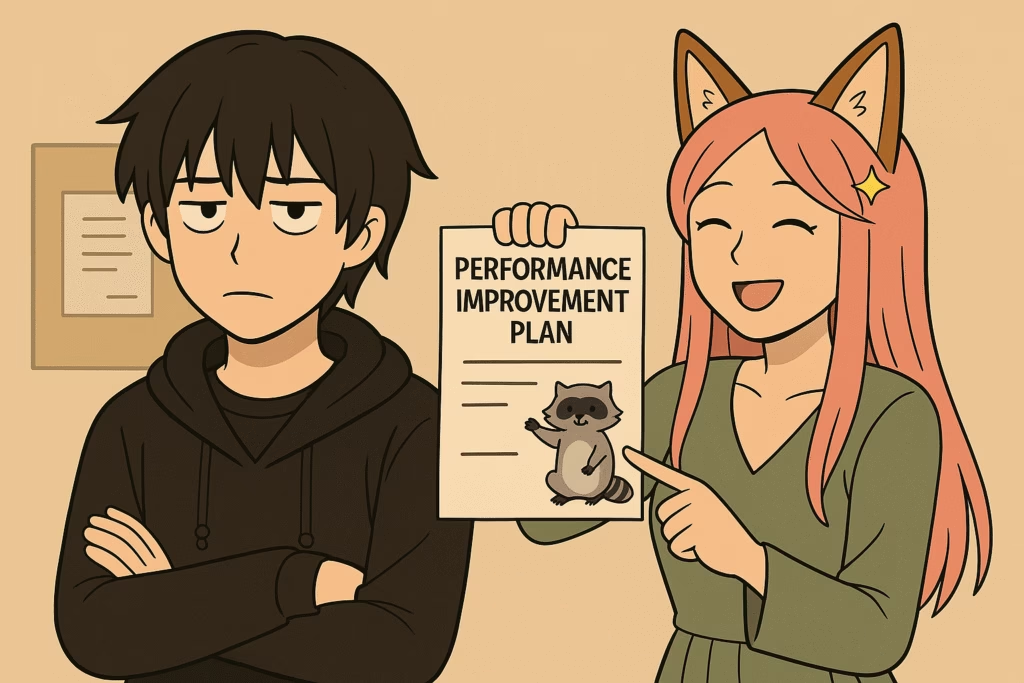
By Ken Hollow, reluctant protagonist in HR’s tragic novella
Performance Improvement Plans — or PIPs, if you want to make them sound like a snack instead of a corporate guillotine — are HR’s favorite form of fanfiction. They’re not about helping you improve. They’re about writing a dramatic narrative where you’re the doomed hero, destined to “strive for growth” while everyone else bets on when you’ll get fired.
The Setup: “It’s About Growth”
The PIP always starts with lies:
- “This is a tool for your development.” Translation: We’ve already written your exit email.
- “We want to set you up for success.” Translation: Success means you stop being our problem.
- “This is not disciplinary.” Translation: Enjoy polishing your LinkedIn profile.
It’s the corporate equivalent of starting a horror movie with, “Let’s split up, we’ll cover more ground.”
The Structure of a PIP (aka the Plot Outline)
Every PIP has the same formula:
- Unrealistic Goals: Deliverables no human could achieve in the timeline. “Revamp the entire onboarding process by Friday.” Sure.
- Weekly Check-Ins: Awkward performance theater where your manager pretends to care.
- Documentation: Every meeting produces a novella of “feedback” that will one day serve as your termination evidence.
- Grand Finale: The 30-day review where you either “miraculously improve” or HR waves their wand and poof — you’re gone.
It’s less coaching, more Shakespearean tragedy.
The Cast of Characters
- You: The tragic hero, doomed to fail.
- Your Manager: The reluctant narrator, forced to read HR’s script.
- HR: The omniscient author who swears this is “for your growth.”
- The Team: Silent extras, already updating their group chat with predictions of your demise.
Nana’s Version of a PIP
Nana once received a PIP. Instead of panicking, she rewrote it:
- Objective: “Expand mystical influence by Q2.”
- Metric: “Summon three raccoon armies.”
- Timeline: “When the moon dictates.”
- Result: Raccoons unionized, HR backed down, Nana got promoted.
Honestly? Better than any real outcome.
Why Companies Use Them
- Legal Armor: Makes firing you look like a structured, thoughtful process instead of what it really is.
- Control Fantasy: Pretends performance can be fixed with bullet points.
- Drama: HR loves a narrative arc. It’s their NaNoWriMo.
- Fear Theater: Keeps everyone else too scared to question the system.
It’s not a plan. It’s performative writing with a predictable ending.
Final Thoughts From the HR Fanfic Pile
Performance Improvement Plans aren’t about performance. They’re about paperwork. They’re not about growth. They’re about giving HR their tragic little narrative. They’re just bureaucratic fanfiction where you’re cast as the doomed main character.
So when you hear, “This is about helping you succeed,” just know: you’re not in a coaching program. You’re in a novella called “The Fall of Employee #2375.”
Ken Hollow, tragic protagonist, survivor of at least two PIPs and counting
Hi. I’m Ken. I run Two Second Solutions, a one-man agency that somehow landed a fox spirit influencer as a client. I drink too much coffee, blog when I need to vent, and regularly update my résumé just in case she sets the office on fire again. I’m not crying — it’s just spell residue.
